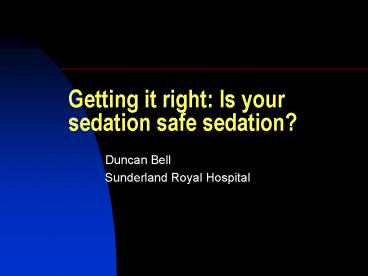Getting it right: Is your sedation safe sedation? - PowerPoint PPT Presentation
1 / 29
Title:
Getting it right: Is your sedation safe sedation?
Description:
... complications and adherence to national and local protocols 4 NHS Trusts should apply to sedation ... For the BSG Endoscopy ... – PowerPoint PPT presentation
Number of Views:545
Avg rating:3.0/5.0
Title: Getting it right: Is your sedation safe sedation?
1
Getting it right Is your sedation safe sedation?
- Duncan Bell
- Sunderland Royal Hospital
2
- Report of an Intercollegiate Working Party
chaired by the Royal College of Anaesthetists - Published November 2001
3
AOMRC
- Implementing and ensuring Safe Sedation Practice
For Healthcare procedures in adults - Available as a pdf file from www.aomrc.org.uk
4
Safe Sedation Practice
- What questions were asked?
- What conclusions were drawn?
- What recommendations were made?
- What are the implications for the BSG and its
members?
5
Existing Guidelines on Sedation Practice
- Poswillo Report 1990
- BSG Recommendations 1991
- RCA and RCR 1992
- RCS Report 1993
6
What conclusions were drawn?
- Existing guidelines on safety, sedation and
monitoring were generally sound. - but
7
- There was evidence to suggest that sedative
drugs are, in some circumstances, being used
unnecessarily, inappropriately, or without
adherence to some of the key components of
published recommendations.
8
Evidence examined
- Included audits of -
- OGD 1995
- Colonoscopy Intercollegiate BSG 2001
- Bronchoscopy (Thorax)1997
- TOEC (Heart) 2000
- As well as -
- Admissions to ITU
- Medico-legal claims
9
Why are the guidelines not always being followed?
- Postgraduate training programmes for specialties
that use sedation techniques frequently do not
include any requirement for specific instruction. - Resulting in many practitioners never receive
formal training in sedation methods.
10
Are the methods used correct?
- .An associated cause for concern is the use,
for sedation and by untrained staff, of drugs
introduced primarily as IV anaesthetics (e.g.
propofol and ketamine) .
11
Are the methods used correct? Propofol and
ketamine
- .Although these drugs have some excellent
properties for use in sedation, very specialised
knowledge, skills and equipment are needed.
Certainly, these drugs cannot, at the present
level of knowledge, be considered as safe for use
by the operator-sedationist .
12
Are the methods used correct?
- .this is not to suggest that the techniques
currently available are perfect because there is
considerable room for development of many
aspects.
13
Are the methods used correct?
- . such development must be carried out in
formal, collaborative research projects, not by
uncontrolled variations in day to day practice.
14
Are the methods used correct?
- .The key point is that safety will be optimised
only if practitioners use defined methods of
sedation for which they have received formal
training .
15
Recommendations
- A) General Principles
- B) New Measures
16
Recommendations
- A) General Principles
- B) New Measures
17
Recommendations
- A) General Principles
- B) New Measures
18
New Measures The Working Party recommends that
- 1
- Royal Colleges, in association with the relevant
sub-specialty organisations, should develop
guidelines on sedation methods appropriate to
clinical practice in their sphere of influence.
19
New Measures The Working Party recommends that
- 2
- Royal Colleges, and their Faculties should
incorporate the necessary instruction and
assessment into training and revalidation
programmes of those specialties that use sedation
techniques.
20
3 Clinical
governance framework at hospital level set up to
ensure a patient centred culture in which -
- Multidisciplinary team training
- Sedationist fully aware of possible
adverse consequences and able to deal with them - Audit of adverse incidents, complications
and adherence to national and local protocols
21
4 NHS Trusts should
apply to sedation techniques the standard of the
Clinical Negligence Scheme which requires that -
- All medical and dental staff in training
be competent in the technical skills and
specified tasks expected of them.
22
5 Each hospital
should -
- nominate two consultants, one an
anaesthetist and the other a user of sedation, to
collaborate in the local implementation of
guidelines and the provision of a specialist
service for patients with particular problems.
23
6 Those responsible
for commissioning and providing healthcare in the
primary and private sectors should -
- ensure that similar processes are in
place to ensure a high standard of sedation
practice.
24
The implementation of recommendations 1-6 will
be aided by -
- Greater focus on clinical governance and
revalidation - As well as
- The current climate requiring greater individual
responsibility for practice - but
25
The implementation of recommendations 1-6 will
also require -
- Adequate resourcing
- Involve people with appropriate knowledge and
skills - Include monitoring and evaluation processes
- Have local as well as national elements
26
For the BSG Endoscopy Committee implementing
1-6 will require -
- Updating of the guidelines on both sedation and
informed consent - Liaison with the Royal Colleges and JAG
- Supporting individual members in their dealings
with their local trusts, anaesthetists, PCGs and
private hospitals - ? Designing and running suitable courses on
Conscious Sedation
27
Are the methods used correct?
- .benzodiazepines have no analgesic properties
when conventional doses are given systemically,
and attempts to use them to control pain will
result in significant overdose.
28
Are the methods used correct?
- .If systemic analgesia is required the opioids
produce a degree of sedation as well, and are
widely used, but they have respiratory depressant
and other adverse effects.
29
Are the methods used correct?
- .Inhalational sedation has an established role
in dental practice and could be used more
frequently in other settings.































